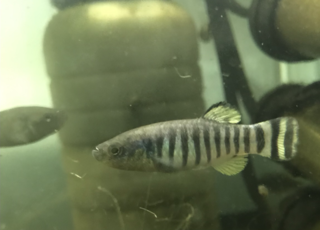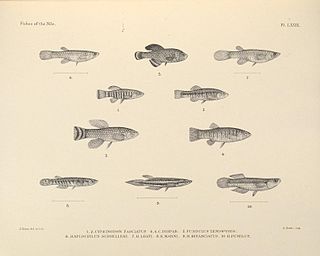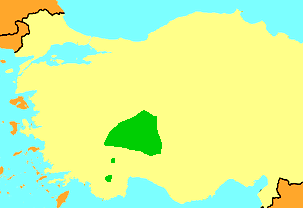
Pupfish are a group of small killifish belonging to ten genera of the family Cyprinodontidae of ray-finned fish. Pupfish are especially noted for being found in extreme and isolated situations. They are primarily found in North America, South America, and the Caribbean region, but Aphanius species are from southwestern Asia, northern Africa, and southern Europe. As of August 2006, 120 nominal species and 9 subspecies were known. Several pupfish species are extinct and most extant species are listed. In the U.S., the most well-known pupfish species may be the Devils Hole pupfish, native to Devils Hole on the Nevada side of Death Valley National Park. Since 1995 the Devils Hole pupfish has been in a nearly steady decline, where it was close to extinction at 35–68 fish in 2013.
Aphanius anatoliae, the Anatolian giant killifish or Lake Tuz toothcarp, is a species of fish in the family Cyprinodontidae. It is endemic to Turkey. It is known from freshwater springs and streams around Lake Tuz, as well as from the Lake Beyşehir basin and from Konya eastward to Niğde. It lives in clear, well-oxygenated running freshwaters. It is threatened by water abstraction and the drying out of streams and springs. It is also impacted by the introduction of Gambusia species.

The Mediterranean killifish, Mediterranean banded killifish or South European toothcarp is a species of fish in the family Cyprinodontidae. It is found in Albania, Algeria, Bosnia and Herzegovina, Croatia, Cyprus, Egypt, France, Greece, Israel, Italy, Lebanon, Libya, Malta, Morocco, Montenegro, Slovenia, Syria, Tunisia, and Turkey. Its natural habitats are saline lakes, saline marshes, and coastal saline lagoons.

Aphanius sirhani, the Azraq toothcarp, is a species of fish in the family Cyprinodontidae. It is endemic to the Azraq Wetland Reserve in Jordan. This species occurs in shallow water where there is vegetation and stones, or over muddy substrates where it feeds on insect larvae and crustaceans. They breed in the Spring.
Aphanius sureyanus, the Burdur toothcarp or Sureyan killifish, is a species of freshwater fish in the family Cyprinodontidae.

Aphanius transgrediens, the Acı Göl toothcarp or Acipinar killifish, is a species of freshwater fish in the family Cyprinodontidae. It is endemic to the springs of Lake Acıgöl in Turkey. It is threatened by a reduction in rainfall from climate change, and the abstraction of water from the springs. The introduction of the non-native eastern mosquitofish also threatens this species.
The scaleless killifish or Hazar toothcarp is a species of freshwater fish in the family Cyprinodontidae. It is the only species in its genus, and is endemic to Lake Hazar in Turkey. It is a pelagic species that comes to shore in spring–early summer to spawn. It is threatened by the falling water levels of Lake Hazar due to water abstraction and reduced rainfall due to climate change.
Leptolebias splendens, also known as the splendid pearlfish or annual tropical killifish, is a species of killifish in the family Rivulidae endemic to Brazil, in the vicinity of Rio de Janeiro. This species was described as Cynolebias splendens in 1942 by George S. Myers with the type locality given as water holes or ponds along the foot of the Serra de Petropolis in Rio de Janeiro State. Deforestation and urbanisation led to the species disappearance from the area of its type locality and it was thought to be extinct but it was rediscovered 5 kilometres (3.1 mi) from the type locality some 70 years after the last known previous record.
Neolamprologus splendens is a species of cichlid endemic to Lake Tanganyika where it is only known to occur around Cape Zongwe in the Democratic Republic of the Congo. The type locality is Near Cape Zongwe, Lake Tanganyika. This species can reach a length of 8 centimetres (3.1 in) TL.

The Permanent Maghreb of World Wide Fund for Nature is a freshwater ecoregion of North Africa.

Anatolichthys danfordii, the Kızılırmak toothcarp or Sultan Sazlığı toothcarp, is a species of killifish belonging to the family Cyprinodontidae. It is endemic to the Kızılırmak River and the upper Seyhan River drainage systems and is now restricted to a few locations in the Sultan Sazlığı marshes. Though little data is available, the population of the fish seems to be declining. The International Union for Conservation of Nature has rated its conservation status as being "critically endangered" and fears it may become extinct in the wild if the drainage of the marshes continues.

The Arabian toothcarp, known also as the Arabian pupfish or mother-of-Pearl fish is a species of killifish belonging to the family Cyprinodontidae. It can be found from the shores of the Red Sea south to Ethiopia, the Gulf of Aden, the Arabian Sea and along the Persian Gulf east to Pakistan and India. It is also found in the Suez Canal, the northern coast of the Sinai Peninsula, and in one location on the Palestinian coast. There are two recognized subspecies: A. d. dispar found throughout the range, and A. d. richardsoni, the Dead Sea toothcarp endemic to the Dead Sea.
The Dead Sea toothcarp is a subspecies of the Arabian toothcarp that is endemic to the Dead Sea basin, although molecular evidence suggests that it should be regarded as a species. It is threatened by water fluctuation, and the introduction of cichlids and Gambusia. The sub-specific name of this fish honours the Scottish surgeon and naturalist John Richardson (naturalist) (1787-1865) who first reported killifish in the Dead Sea basin. The Dead Sea toothcarp -- has been on the red list of the International Union for Conversation of Nature since 2014.
The Sakarya toothcarp is a species of freshwater fish in the family Cyprinodontidae. It is endemic to the upper Sakarya River basin in Turkey. It is threatened by water abstraction, damming and a reduction of rainfall due to climate change. The specific name honours the German zoologist Wolfgang Villwock (1930-2014) of the University of Hamburg.

Pelophylax caralitanus, commonly known as the Anatolian frog or Beyşehir frog, is a species of frog in the family Ranidae. It is endemic to southern Turkey and is considered vulnerable to extinction by the International Union for Conservation of Nature (IUCN).

The Almiri toothcarp or Almiri killifish is a species of pupfish belonging to the family Cyprinodontidae. It can be found in a handful of brackish springs and marshes in the Peloponnese, Greece. Due to one of the springs being dammed up with rocks in the late 1990s to early 2000s, the IUCN considers the fish to be critically endangered on criteria B1ab and B2ab ; it is possibly extinct at its type locality.
The Lake Afdera killifish is a species of fish in the family Cyprinodontidae. It is found in Lake Afdera in Ethiopia. The species was evaluated by the IUCN on 1 May 2009 and listed as endangered on the Red List.
Apricaphanius saourensis, the Sahara aphanius, is a species of freshwater pupfish belonging to the family Cyprinodontidae. It is endemic to the Oued Saoura river basin in Algeria. The species is threatened by water pollution and water withdrawal for agricultural use; it was evaluated by the IUCN on 17 October 2007 and listed as critically endangered on the Red List, although it is possibly extinct in the wild.









